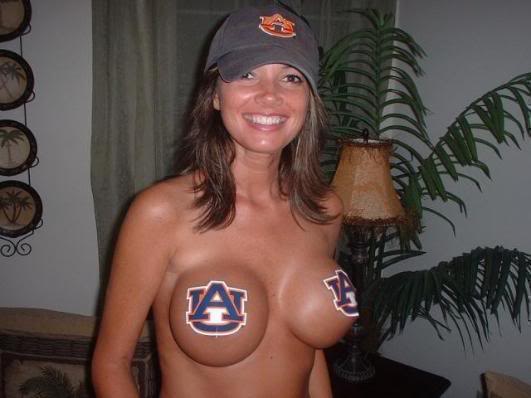Auburn, located in a southern corner of the state, is a former agricultural school whose campus is a cultural island amid a sea of red state farmlands. The University of Alabama has a truly old campus in urban Tuscaloosa. Both are now premier universities sharing a century's history of big games and cult figures.
Among these is Paul "Bear" Bryant, the man in the houndstooth hat. Besides coaching Alabama to countless victories over the decades, Bryant was the first coach in the Southeastern Conference to recruit Black athletes. In fact, his decision in 1971 was something of a watershed for race relations in the south: by 1973, the entire SEC was integrated, and arch-segregationist George Wallace had opened Alabama's state government to Blacks.
 But Bryant's biggest legacy is a tradition of victory. His iconography is ubiquitous; he is a patron saint to millions, always pictured wearing the hat. Indeed, Alabama's religion has created quite the consumer kitsch-culture, with flags mounted on vehicles year-round and large stickers proclaiming allegiances; but the big, recent trend is simply a magnetic sticker of the hat. Far less common are elephants, which were the team mascot long before Bryant was their coach.
But Bryant's biggest legacy is a tradition of victory. His iconography is ubiquitous; he is a patron saint to millions, always pictured wearing the hat. Indeed, Alabama's religion has created quite the consumer kitsch-culture, with flags mounted on vehicles year-round and large stickers proclaiming allegiances; but the big, recent trend is simply a magnetic sticker of the hat. Far less common are elephants, which were the team mascot long before Bryant was their coach.Auburn fans have no shortage of this crass, commercial stuff either, and are never ashamed to display it with proud prominence. Upon entering the state, you will find it the color schemes of both teams everywhere, even in the most inappropriate places.


These bottles are incredibly common throughout the state. I've never found one that wasn't enshrined like a holy relic on mantle, shelf, or windowsill:
 Alabama has the most national championships of any college team. Auburn has its share of glories, and among them is a (possibly apocryphal) game in which an eagle soared over the stadium as the team won a huge comeback upset of Alabama. The story led to Auburn's somewhat unique position of having two mascots: they are the Auburn Tigers, but the school keeps a live (rescued!) eagle on display.
Alabama has the most national championships of any college team. Auburn has its share of glories, and among them is a (possibly apocryphal) game in which an eagle soared over the stadium as the team won a huge comeback upset of Alabama. The story led to Auburn's somewhat unique position of having two mascots: they are the Auburn Tigers, but the school keeps a live (rescued!) eagle on display.The name for their rivalry, "Iron Bowl," is an archaeism. For decades, the game was held in neutral territory at Legion Field in Birmingham; apart from a sad Civil Rights legacy, the city is best known for having once been a major steel producer. Today, the largest foundry is a museum and concert location with a reputation for being haunted by the ghosts of non-union workers, but the name remains attached to this perennial battle. Perhaps it is fitting, as American football is a game of the industrial age.
Moreover, football is a creation of marketing. As I explained, both teams reinforce their rivalry with every sort of consumable. An exceedingly small sample of Alabama residents have ever visited, much less attended either university, yet I have seen couples break up and friendships end over this game. Tribalism is rampant, and encouraged.
Thus the Iron Bowl is our archaeic ritual sacrifice; it is surrounded by an industry of charms, wards, and icons. Despite the involvement of a Crimson Tide, precious little blood is spilt by these latter-day gladiators, who wear layers of high-impact plastic and protective padding. The church of football does not want victims, but fans; the libation is Gatorade and the offering is sweat.
If you visit this state, bear one cultural rule in mind: there are only two denominations of our state religion, and they are always at war. Rumors of a third option persist in the northern reaches around Huntsville, but these folk are held harmless cranks by most -- and heretics by some. Avoid a lynching by leaving your orange-and-white color schemes at home.
